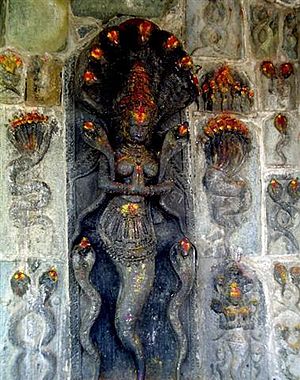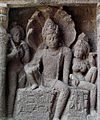Snake worship facts for kids
Snake worship is when people show respect and devotion to snakes. This practice has been around for a very long time in many different cultures around the world. In old stories and beliefs, snakes were often seen as symbols of power, or of new beginnings and life.
Contents
Snakes in Ancient Beliefs
Snakes have played important roles in many ancient religions and myths. People often saw them as special creatures with deep meanings.
Snakes in Hindu Mythology
In Hinduism, snakes are called Nagas. They are very important symbols. Nagas represent ideas like rebirth, death, and how life keeps changing. This is because snakes shed their skin, which looks like they are being "reborn" into a new form.
Snakes in Greek Mythology
Snakes also appear a lot in Greek mythology. Some ancient Greek stories even talk about a snake-like creature called "Ophion." He was believed to be one of the first rulers of the world.
Snakes in Gnosticism
The Gnostics were a group of people with special religious beliefs. They thought of the snake as a "god of good." For them, the snake was a symbol of wisdom and knowledge.
Images for kids
-
A snake design on Bronze Age pottery found in Rumailah, Al Ain.
-
A lion-faced, snake-like deity from a Gnostic gem. This might show the Demiurge.
-
Mami Wata, a spirit who is very important in many African and African-American religions.
-
A classic Maya vision serpent, shown at Yaxchilan.
-
The Raimondi Stela from the Chavín culture in Ancash, Peru. It shows a figure with fangs, claws, and snakes for hair.
-
Manasa in a village in the Sundarbans, West Bengal, India.
-
A roadside temple dedicated to Snakes in Tamil Nadu, India.
-
A statue of Asclepius in the Pergamon Museum, Berlin.
-
The Snake God Naga and his partner. This photo is from the cave temples of Ajanta, Maharashtra, India.
-
A design of a snake goddess. This carving is on volcanic rock at the Kailash Temple, Ellora, India.



















